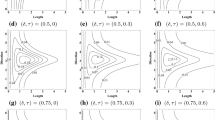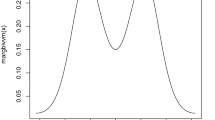Abstract
The objective of this paper is to perform clustering based on data consisting of both linear and circular variables, that is the data that lie on the surface of a cylinder. There are many circular–linear distributions available in the literature. We use the pragmatic approach of specifying the conditional rather than the marginal, which is often easier. Adopting Arnold et al. (Lecture Notes in Statistics: Conditionally Specified Distributions, Springer Verlag Publisher, Berlin Heidelberg, 1992), we provide the conditional distribution of θ given x and that of x given θ. Here, a mixture model approach based on the joint distribution of the linear and the circular variable is proposed. In particular, two types of such mixture models are used. One is based on the joint distribution of the marginal distribution of the linear variable and the conditional distribution of the circular variable given the linear variable and the other vice versa. Convergence property of Expectation Maximization (EM) algorithm for the members of the curved exponential family used for our models is studied. A real-life application on meteorological data is made of the proposed approaches. Comparison of the two models is done based on this example. The distinctive and important feature of preserving the geometry of the cylindrical manifold by our clustering method and its marked deviation from that for data on \(\Re ^p\) is also revealed by this example.
Access this chapter
Tax calculation will be finalised at checkout
Purchases are for personal use only
Similar content being viewed by others
References
Abe, T., Ley, C. (2017). A tractable, parsimonious and highly flexible model for cylindrical data, with applications. Econometrics and Statistics, 4, 91–104.
Arnold, B. C., Castillo, E., Sarabia, J. M. (1992). Conditionally specified distributions. Lecture Notes in Statistics. Berlin Heidelberg: Springer.
Dingxi, Q., Tamhane, A. (2007). A comparative study of k-means algorithm and the normal mixture model for clustering: Univariate case. Journal of Statistical Planning and Inference, 137, 3722–3740.
Fisher, N. I., Lee, A. J. (1992). Regression models for an angular response. Biometrics, 48(3), 665–677.
Green, P. J. (1984). Iteratively reweighted least squares for maximum likelihood estimation, and some robust and resistant alternatives. Journal of the Royal Statistical Society, Series B, 46, 149–192.
Jammalamadaka, S. R., SenGupta A. (2001). Topics in circular statistics. New Jersey: World Scientific Publishers.
Johnson, R. A., Wehrly, T. E. (1978). Some angular-linear distributions and related regression models. Journal of the American Statistical Association, 73, 602–606.
Johnson, R. A., Wichern, D. W. (2007). Applied multivariate statistical analysis. New Jersey: Pearson Prentice Hall
Kato, S., Shimizu, K. (2008). Dependent models for observations which include angular ones. Journal of Statistical Planning and Inference, 138, 3538–3549.
Lagona, F., Picone, M., Maruotti, A. (2015). A Hidden Markov model for the analysis of cylindrical time series. Environmetrics, 26, 534–544.
Mardia, K. V., Sutton, T. W. (1978). A model for cylindrical variables with applications. Journal of the Royal Statistical Society. Series B (Methodological), 40(2), 229–233.
McLachlan, G. J., Krishnan, T. (1997). The EM algorithm and extensions. New York: Wiley.
McLachlan, G. J., Peel, D. (2001). Finite mixture models. Wiley Series in Probability and Statistics, United States of America. Hoboken: Wiley.
Modlin, D., Fuentes, M., Reich, B. (2012). Circular conditional autoregressive modeling of vector fields. Environmetrics, 23, 46–53.
Seal, B., SenGupta, A. (2012). On the foundations of dependency models and parameters for random variables on cylinder. Calcutta Statistical Association Bulletin, 64, 151–165.
SenGupta, A. (2004). On the construction of probability distributions for directional data. Bulletin of the Calcutta Mathematical Society, 96(2), 139–154.
SenGupta, A., Ugwuowo, F. (2006). Asymmetric circular-linear multivariate regression models with applications to environmental data. Environmental and Ecological Statistics, 13(3), 299–309.
Vermunt, J. K., Magidson, J. (2005). Hierarchical mixture models for nested data structures. In C. Weihs, W. Gaul (Eds.), Classification – the ubiquitous challenge. Studies in Classification, Data Analysis, and Knowledge Organization (pp. 240–247). Berlin: Springer.
Wu, J. C. F. (1983). On the convergence properties of the EM algorithm. Annals of Statistics, 11(1), 95–103.
Acknowledgements
The authors greatly appreciate the thorough and scholarly report on the paper by the Referee and express their thanks hereby. The research of the second author of the paper was funded by the Senior Research Fellowship from the University Grants Commission, Government of India. She is also thankful to the Indian Statistical Institute and the University of Calcutta for providing the necessary facilities.
Author information
Authors and Affiliations
Editor information
Editors and Affiliations
Rights and permissions
Copyright information
© 2021 Springer Nature Switzerland AG
About this chapter
Cite this chapter
SenGupta, A., Roy, M., Chattopadhyay, A.K. (2021). Model-Based Clustering for Cylindrical Data. In: Ghosh, I., Balakrishnan, N., Ng, H.K.T. (eds) Advances in Statistics - Theory and Applications. Emerging Topics in Statistics and Biostatistics . Springer, Cham. https://doi.org/10.1007/978-3-030-62900-7_17
Download citation
DOI: https://doi.org/10.1007/978-3-030-62900-7_17
Published:
Publisher Name: Springer, Cham
Print ISBN: 978-3-030-62899-4
Online ISBN: 978-3-030-62900-7
eBook Packages: Mathematics and StatisticsMathematics and Statistics (R0)




